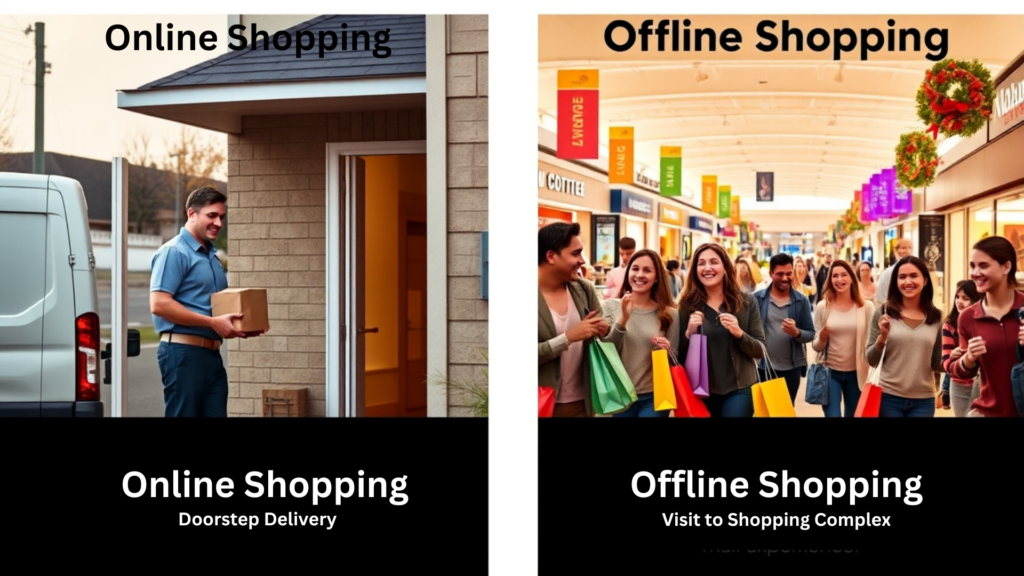Are you finding yourself shopping online more frequently these days? If so, you’re not alone. The convenience of ordering anything you need with just a few clicks is hard to resist, especially with busy schedules.
Visit to Shopping Complex
We often fall prey to Best Offers – Isn’t it?

Recently, I visited a mall and couldn’t help but notice the lively energy all around. Shoppers were bustling about, arms full of shopping bags, chatting with friends or engaging in polite smiles with strangers. It struck me how simple interactions, like a shared smile or a nod, can enhance our social skills in subtle but meaningful ways.

As I stood waiting in a queue, I overheard a conversation that caught my attention. A few people were grumbling about the wait, and one remarked how much easier it would be to just order online. It made me realize how impatience has seeped into our everyday lives, with some even taking out their frustration on delivery personnel, forgetting that traffic and logistical challenges are often beyond their control.

This small experience highlighted a larger issue: while online shopping has made our lives easier in some ways, it has also diminished our ability to tolerate delays and handle face-to-face interactions gracefully. Impatience has replaced the calm acceptance that used to come naturally when waiting in lines. This growing trend of opting for instant digital solutions is slowly stripping away the essential life skills we acquire through in-person shopping—skills like patience, social interaction, empathy, and even physical movement.
Below, I explore how online shopping, though convenient, is costing us these vital experiences and social abilities.
1. Eroding Social Interaction
When we shop in physical stores, there’s an element of social interaction that goes beyond a mere transaction. From greeting the shopkeeper to making small talk with fellow shoppers, these seemingly minor engagements contribute to our overall social well-being.
By opting for online shopping, we lose the opportunity to:
- Practice the art of casual conversation.
- Develop interpersonal skills by communicating face-to-face.
- Engage in the community by visiting local shops and markets.
This loss of social mix-up may seem trivial, but it plays a significant role in human connectivity. Over time, reliance on virtual shopping can make real-world interactions feel unfamiliar and uncomfortable.
2. The Forgotten Value of Patience
Standing in queues is often seen as a hassle, but it serves an important purpose. Waiting teaches us patience and how to handle minor inconveniences. In an era where instant gratification is the norm, the act of waiting is a rare and valuable skill.

When you stand in line:
- You learn to manage time.
- It offers moments of reflection, where your mind can wander or relax.
- You develop tolerance for delays and the unexpected.
Online shopping, with its instant checkouts and next-day delivery, diminishes our ability to deal with real-world waiting, leading to frustration when faced with delays in other areas of life.
3. Missing Out on Exercise – Both Mental and Physical
Going out for shopping is not just about the products you buy; it’s an activity that stimulates both your body and mind. The act of moving from store to store, carrying bags, and navigating aisles adds a dose of physical activity to your day. Even mentally, you are more engaged as you compare products, prices, and make on-the-spot decisions.

Online shopping, by contrast, removes these layers of effort:
- You sit in one place, making it easier to slip into a sedentary lifestyle.
- Mental stimulation is reduced to scrolling through lists and filtering options, which doesn’t challenge cognitive processes the same way in-store shopping does.
- The focus shifts to speed and efficiency, which often leads to impulsive purchasing rather than thoughtful decision-making.
In essence, shopping in person keeps both your body and mind more active and engaged, offering a form of low-intensity exercise that is lost when replaced by online browsing.
4. The Decline of Customer Service Skills
Interacting with shopkeepers is an underappreciated skill that many of us unconsciously develop over time. Negotiating prices, asking for help, or simply engaging in polite conversation with staff helps us sharpen our communication abilities. It also instills a level of respect for service providers and empathy for the work they do.

With online shopping:
- Customer service is reduced to chatbots or impersonal emails.
- There’s no opportunity for negotiation, clarification, or personal interaction with staff.
- The overall shopping experience becomes transactional rather than relational, impacting how we relate to people who work in service industries.
Over time, this detachment can lead to a diminished ability to handle real-life situations where customer service or direct interaction is required.
5. Losing the Joy of Exploring New Environments
When shopping in person, you are exposed to new environments, be it a bustling marketplace, a serene bookstore, or a lively shopping mall. These outings can be refreshing for the mind, offering a change of scenery and an opportunity to observe human behavior and trends.

In contrast, online shopping offers none of these experiences. It is predictable, confined to a screen, and repetitive. The joy of exploration and spontaneity is often replaced with algorithm-driven suggestions that limit your exposure to new products or ideas.
6. Community Engagement and Supporting Local Businesses
Lastly, shopping in physical stores allows you to engage with your local community and support small businesses. These interactions foster a sense of belonging and contribute to the local economy. As we shift to e-commerce giants, we often overlook the importance of local shops that rely on regular foot traffic to survive.
By visiting physical stores:
- You become part of a network that supports artisans, small entrepreneurs, and local craftsmen.
- You engage with the people in your neighborhood, which fosters community ties and strengthens the local economy.
While online shopping may be convenient, it often bypasses these important community-building opportunities, leading to a more isolated and disconnected experience.
7. Offline Shopping: A Natural Stress Buster
In today’s fast-paced digital world, offline shopping offers more than just the chance to buy things—it’s a refreshing escape from the monotony of screens and endless notifications. Walking through a store, exploring aisles, touching and feeling products, and making thoughtful purchasing decisions can be surprisingly therapeutic. Offline shopping allows you to unplug, focus on the present moment, and indulge in a physical experience that engages your senses.

The atmosphere of a lively mall or a serene boutique can lift your mood, reduce stress, and provide a break from the overwhelming demands of work or life. It’s not just about the purchases; it’s about giving your mind a break, embracing the spontaneity of discovering new items, and enjoying the overall experience. So, the next time you feel stressed or bogged down, consider heading out to your favorite store—not only for what you may buy, but for the mental reset you didn’t even know you needed.
Conclusion
While online shopping is undeniably convenient and perfect for those moments when you need something quickly or can’t step out, it’s essential to strike a balance. Whenever possible, make it a point to visit physical stores, not just to purchase items, but to engage with your surroundings, enjoy the social experience, and nurture valuable interpersonal skills.

Walking into a store, browsing through products, and interacting with shopkeepers and fellow shoppers offers a sense of connection that online shopping simply cannot replicate. These outings provide moments of joy, strengthen social bonds, and offer physical and mental engagement that is often lost in the digital world. By balancing the convenience of online shopping with the enriching experience of in-person visits, we maintain a more holistic approach to life, fostering both efficiency and human connection.